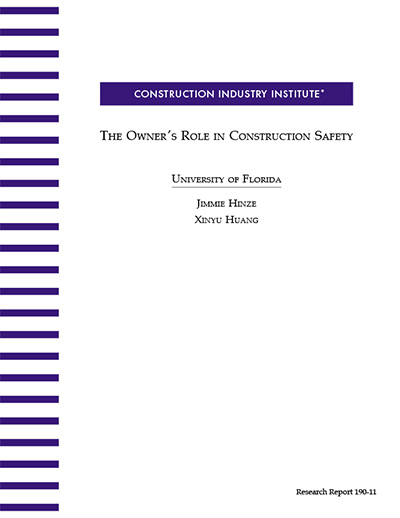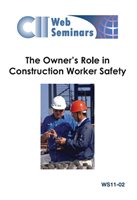
The Owner's Role in Construction Safety
The construction industry has long been regarded as one of the most dangerous industries, primarily due to its history of poor safety performance. This is despite the fact that dramatic improvements have been made in the safety performance of the construction industry in the past decade. The improvements are due, in varying degrees, to the efforts of owners, contractors, subcontractors, and designers. While past safety studies have investigated the roles of contractors, subcontractors, and designers, the owner’s impact on construction safety has not been thoroughly studied.
The owners of projects are the primary consumers of construction services, the sources of project finances, and, in many cases, the end users of the facilities. They regularly play a key role in project development. Traditionally, owners have not been directly involved in construction safety, primarily to avoid economic losses and legal entanglements resulting from injuries. With the increase of accident costs and legal cases involving owners as the third-party defendants, owners have come to realize that they cannot ignore safety.
In this study, the owner’s role in construction safety was investigated. The relationship between project safety performance and the owner’s influence was examined, with particular focus on the project context, selection of safe contractors, contractual safety requirements, and the owner’s proactive involvement in safety management. A questionnaire survey sent to owners with large construction budgets and interviews conducted on projects with large worker hour exposures were the two means of data collection for the study. Statistical analysis shows that there is a strong relationship between project safety performance and owner involvement. Practices of owners that favorably impacted project safety performances were identified, including:
- Project context: Project characteristics related to better safety performance include petrochemical projects, private projects, open-shop projects, projects with design-build contracts, projects of fairly large or small size (not medium size), projects working one shift, and projects working five or less workdays per week.
- Careful selection of safe contractors: Owners aggressive in safety use proactive criteria to evaluate and select contractors. These criteria include the contractor’s total recordable injury rate (TRIR) on past projects, qualifications of the contractor’s safety staff, qualifications of the contractor’s project management team, and the assessed quality of the contractor’s overall safety program.
- Contractual safety requirements: Contractual safety requirements should clearly convey the owner’s emphasis on safety and the owner’s expectation of a safe project. Five contractual requirements were identified as being leading (safety promoting) indicators, and they are listed as follows:
- Contractor must place at least one full-time safety representative on the project
- Contractor must submit the resumes of key safety personnel for the owner’s approval
- Contractor must provide specified minimum training for the workers
- Contractor must submit a site-specific safety plan
- Contractor must submit a safety policy signed by its CEO
- Owner’s proactive involvement in the safety practices of projects: The owner’s direct involvement in the safety process during construction is perhaps the most important role that the owner can play to favorably impact project safety performance. The key measurements employed by the owners with better safety performances are identified as:
- Owners set their expectations on safety from the very beginning of a project, especially the zero-injury objective;
- Owners impose requirements on the safety programs developed by contractors and emphasize specific items, including: emergency plan (medical and hazardous materials), daily JSA (job safety analysis) conducted on the project site, and a mandated substance abuse program;
- Owners monitor near miss rates and the safety inspection records on the projects, besides other types of injury statistics (TRIR, lost-time injury rate, etc);
- Owners maintain accident statistics by contractor on their projects, and also include the contractor’s injury statistics in their own accident records;
- Owners participate in the safety recognition program and financially support the program;
- Owners actively participate in safety training and orientation and verify the comprehension of the training (such as by testing);
- Owners assign a full-time safety representative on site with various responsibilities including: enforcing safety rules; reviewing safety performance on site and submitting reports to the home office; monitoring pre-task analysis programs; participating in safety recognition programs; and participating in safety and/or tool box meetings.
Based on a statistical analysis, a model to demonstrate how owners can help improve safety was established. A scorecard was developed to assess the owner’s level of involvement in safety and this scorecard tested on several projects.
It was concluded that the owner’s involvement significantly influences project safety performance. Better project safety performances are achieved when owners set safety objectives, select safe contractors, and participate in safety management during construction.


